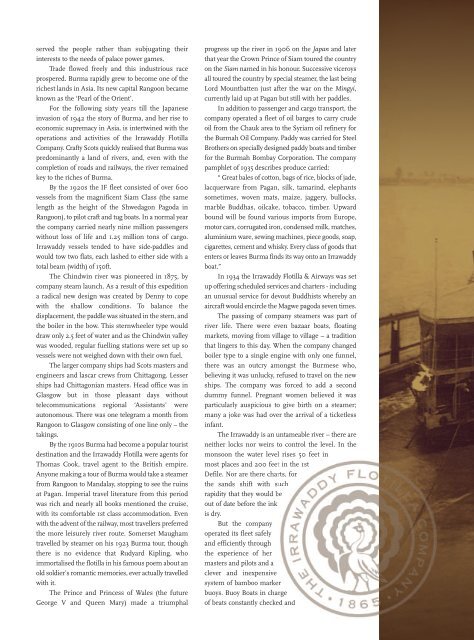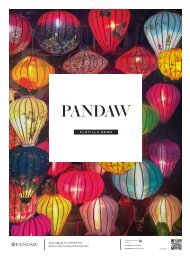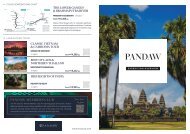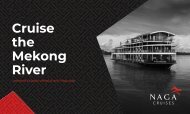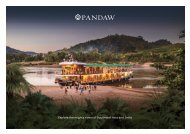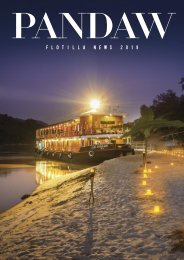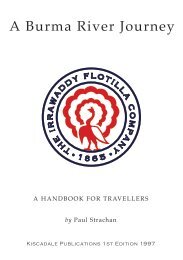Pandaw Magazine
Pandaw magazine 2016.
Pandaw magazine 2016.
Create successful ePaper yourself
Turn your PDF publications into a flip-book with our unique Google optimized e-Paper software.
served the people rather than subjugating their<br />
interests to the needs of palace power games.<br />
Trade flowed freely and this industrious race<br />
prospered. Burma rapidly grew to become one of the<br />
richest lands in Asia. Its new capital Rangoon became<br />
known as the ‘Pearl of the Orient’.<br />
For the following sixty years till the Japanese<br />
invasion of 1942 the story of Burma, and her rise to<br />
economic supremacy in Asia, is intertwined with the<br />
operations and activities of the Irrawaddy Flotilla<br />
Company. Crafty Scots quickly realised that Burma was<br />
predominantly a land of rivers, and, even with the<br />
completion of roads and railways, the river remained<br />
key to the riches of Burma.<br />
By the 1920s the IF fleet consisted of over 600<br />
vessels from the magnificent Siam Class (the same<br />
length as the height of the Shwedagon Pagoda in<br />
Rangoon), to pilot craft and tug boats. In a normal year<br />
the company carried nearly nine million passengers<br />
without loss of life and 1.25 million tons of cargo.<br />
Irrawaddy vessels tended to have side-paddles and<br />
would tow two flats, each lashed to either side with a<br />
total beam (width) of 150ft.<br />
The Chindwin river was pioneered in 1875, by<br />
company steam launch. As a result of this expedition<br />
a radical new design was created by Denny to cope<br />
with the shallow conditions. To balance the<br />
displacement, the paddle was situated in the stern, and<br />
the boiler in the bow. This sternwheeler type would<br />
draw only 2.5 feet of water and as the Chindwin valley<br />
was wooded, regular fuelling stations were set up so<br />
vessels were not weighed down with their own fuel.<br />
The larger company ships had Scots masters and<br />
engineers and lascar crews from Chittagong. Lesser<br />
ships had Chittagonian masters. Head office was in<br />
Glasgow but in those pleasant days without<br />
telecommunications regional ‘Assistants’ were<br />
autonomous. There was one telegram a month from<br />
Rangoon to Glasgow consisting of one line only – the<br />
takings.<br />
By the 1910s Burma had become a popular tourist<br />
destination and the Irrawaddy Flotilla were agents for<br />
Thomas Cook, travel agent to the British empire.<br />
Anyone making a tour of Burma would take a steamer<br />
from Rangoon to Mandalay, stopping to see the ruins<br />
at Pagan. Imperial travel literature from this period<br />
was rich and nearly all books mentioned the cruise,<br />
with its comfortable 1st class accommodation. Even<br />
with the advent of the railway, most travellers preferred<br />
the more leisurely river route. Somerset Maugham<br />
travelled by steamer on his 1923 Burma tour, though<br />
there is no evidence that Rudyard Kipling, who<br />
immortalised the flotilla in his famous poem about an<br />
old soldier’s romantic memories, ever actually travelled<br />
with it.<br />
The Prince and Princess of Wales (the future<br />
George V and Queen Mary) made a triumphal<br />
progress up the river in 1906 on the Japan and later<br />
that year the Crown Prince of Siam toured the country<br />
on the Siam named in his honour. Successive viceroys<br />
all toured the country by special steamer, the last being<br />
Lord Mountbatten just after the war on the Mingyi,<br />
currently laid up at Pagan but still with her paddles.<br />
In addition to passenger and cargo transport, the<br />
company operated a fleet of oil barges to carry crude<br />
oil from the Chauk area to the Syriam oil refinery for<br />
the Burmah Oil Company. Paddy was carried for Steel<br />
Brothers on specially designed paddy boats and timber<br />
for the Burmah Bombay Corporation. The company<br />
pamphlet of 1935 describes produce carried:<br />
“ Great bales of cotton, bags of rice, blocks of jade,<br />
lacquerware from Pagan, silk, tamarind, elephants<br />
sometimes, woven mats, maize, jaggery, bullocks,<br />
marble Buddhas, oilcake, tobacco, timber. Upward<br />
bound will be found various imports from Europe,<br />
motor cars, corrugated iron, condensed milk, matches,<br />
aluminium ware, sewing machines, piece goods, soap,<br />
cigarettes, cement and whisky. Every class of goods that<br />
enters or leaves Burma finds its way onto an Irrawaddy<br />
boat.”<br />
In 1934 the Irrawaddy Flotilla & Airways was set<br />
up offering scheduled services and charters - including<br />
an unusual service for devout Buddhists whereby an<br />
aircraft would encircle the Magwe pagoda seven times.<br />
The passing of company steamers was part of<br />
river life. There were even bazaar boats, floating<br />
markets, moving from village to village – a tradition<br />
that lingers to this day. When the company changed<br />
boiler type to a single engine with only one funnel,<br />
there was an outcry amongst the Burmese who,<br />
believing it was unlucky, refused to travel on the new<br />
ships. The company was forced to add a second<br />
dummy funnel. Pregnant women believed it was<br />
particularly auspicious to give birth on a steamer;<br />
many a joke was had over the arrival of a ticketless<br />
infant.<br />
The Irrawaddy is an untameable river – there are<br />
neither locks nor weirs to control the level. In the<br />
monsoon the water level rises 50 feet in<br />
most places and 200 feet in the 1st<br />
Defile. Nor are there charts, for<br />
the sands shift with such<br />
rapidity that they would be<br />
out of date before the ink<br />
is dry.<br />
But the company<br />
operated its fleet safely<br />
and efficiently through<br />
the experience of her<br />
masters and pilots and a<br />
clever and inexpensive<br />
system of bamboo marker<br />
buoys. Buoy Boats in charge<br />
of beats constantly checked and


